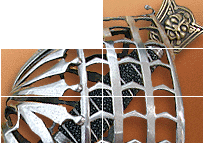| Author |
Message |
|
Jeffrey Faulk
|
 Posted: Thu 19 Nov, 2015 1:04 pm Post subject: Type U pommel similarities Posted: Thu 19 Nov, 2015 1:04 pm Post subject: Type U pommel similarities |
 |
|
Hello all,
Seeing a few posts from myArmoury on Facebook I was struck by the lovely type U pommel and cross on one piece, and then the thought occurred to me-- where had I seen that design before? Isn't there rather a strong resemblance between many of these type pommels?
Most notably there is this thread, though I have had issues doing a search on the website for more, I found it easier eventually to use Google 'site:myArmoury.com [so and so]'.
http://myArmoury.com/talk/viewtopic.php?t=13868
There are of course a few modern reproductions with this pommel type, the best known probably being the Albion Viceroy and the Arms and Armour English Longsword, though Mike Jia of Printed Armoury is producing a set of hilt fittings using this pommel type for Hanwei-Tinker bastard sword blades.
http://myArmoury.com/review_aa_els.html
https://myArmoury.com/talk/viewtopic.php?p=303704
If you would like to see the myArmoury facebook page for the pictures that (I believe) Nathan posted, here:
https://www.facebook.com/myArmoury/


Notably, from bottom to top (so to speak):
--The 'stem' of the pommel is generally squarish or hexagonal in section.
--There is a sharp transition from the 'stem' to the oval segment of the pommel.
-- A pronounced mid-rib is quite common as well; this is occasionally decorated with file-work.
--The lot of it culminates in a finial on top.
You can see this in the other 'Type U' thread as well:

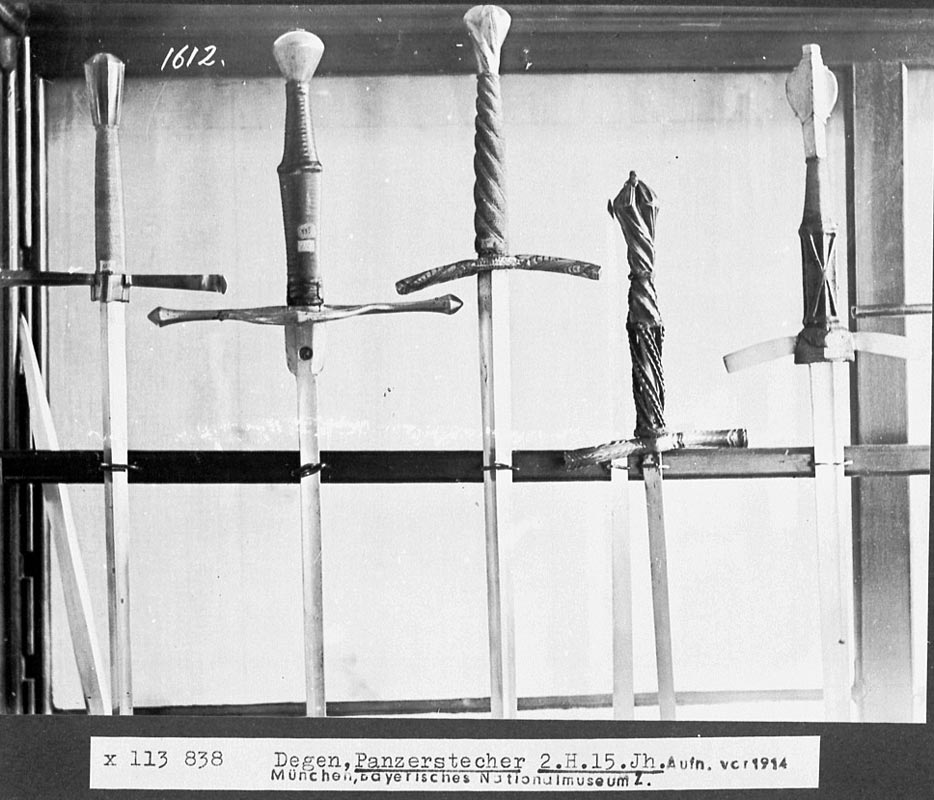
This next one is somewhat of a divergence as it does not have the sharp transition from stem to oval, but otherwise it follows the rest of the form:
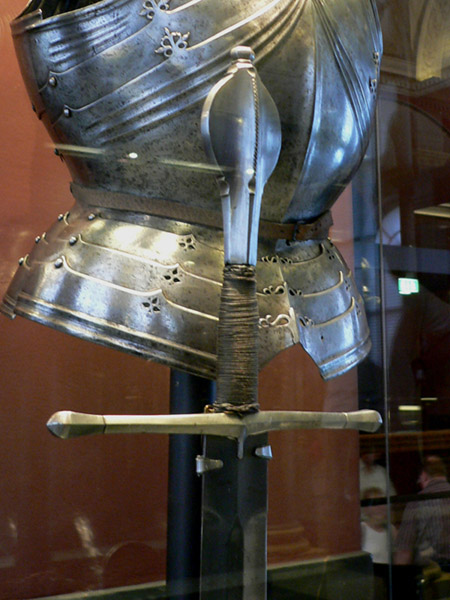
The guard designs also are very consistent throughout with these pommels-- generally a square section (turned so that the corners present themselves) or hexagonal, with a flat section in the middle where the blade goes through. There is more variation than with the pommels, though.
Seeing this striking consistency in general design, especially coupled with how it's not a very common design, I am tempted to wonder-- is this a sign that the majority of swords made in this manner have a very specific origin? Were they made in the same shop or by the same craftsman? Certainly not all were-- there is sufficient variation to show this. But there are quite a few here, that have extreme similarities (even down to the little bit of file-work at the edges where oval and stem join).
Share your thoughts! Or more pictures of this type, if you have any!
|
|
  |
 |
J. Nicolaysen

|
|
  |
 |
|
Jeffrey Faulk
|
 Posted: Thu 19 Nov, 2015 1:51 pm Post subject: Posted: Thu 19 Nov, 2015 1:51 pm Post subject: |
 |
|
The hunting sword there has what seems to me to be a type V1 pommel... it lacks the pronounced and distinct lines that tend to be notable of type U pommels. It could certainly be viewed as an extreme outlier of the type, though.
http://myArmoury.com/feature_oakeshott3.html#pommelV1
|
|
  |
 |
Nathan Robinson
myArmoury Admin


|
|
    |
 |
Nathan Robinson
myArmoury Admin


|
|
    |
 |
Nathan Robinson
myArmoury Admin


|
|
    |
 |
|
Jeffrey Faulk
|
 Posted: Thu 19 Nov, 2015 4:20 pm Post subject: Posted: Thu 19 Nov, 2015 4:20 pm Post subject: |
 |
|
|
Splendid pictures! Thank you! Do you have any thoughts on this phenomenon?
|
|
  |
 |
|
Mark Lewis
|
 Posted: Thu 19 Nov, 2015 8:49 pm Post subject: Posted: Thu 19 Nov, 2015 8:49 pm Post subject: |
 |
|
Here are a few more...
Held in Vienna, this ornate ceremonial sword was a gift from King Mathias Corvinus of Hungary to the city of Ragusa/Dubrovnik:

(full size image here: https://upload.wikimedia.org/wikipedia/commons/1/1a/KHM_Wien_A_141_-_Ceremonial_sword_of_the_Rector_of_the_Republic_of_Ragusa,_1466.jpg)
Also in Vienna is a sword given to the Emperor Maximilian upon his wedding to Bianca Sforza in 1494:
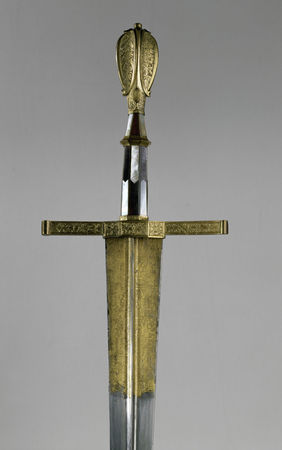
Somewhat similar to the latter (more so in the form of the blade than the pommel) is another ceremonial sword held in Friuli, anachronistically attributed to the 14th c. patriarch Marquard of Randeck:
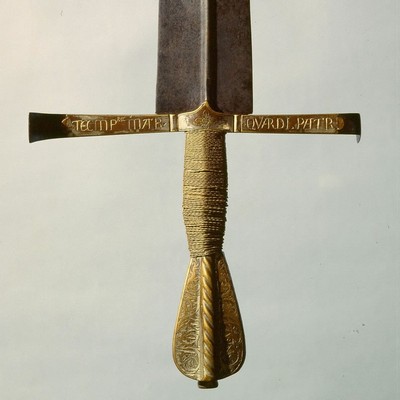
Finally there is a another sword held by the Swiss Museum in Zurich:

|
|
   |
 |
|
Jeffrey Faulk
|
 Posted: Fri 20 Nov, 2015 9:29 am Post subject: Posted: Fri 20 Nov, 2015 9:29 am Post subject: |
 |
|
| Mark Lewis wrote: | Somewhat similar to the latter (more so in the form of the blade than the pommel) is another ceremonial sword held in Friuli, anachronistically attributed to the 14th c. patriarch Marquard of Randeck:

|
Now that is interesting. It almost looks like the craftsman was trying to *copy* the more usual run of type U pommels by adding a central rib and finial to a type V1 pommel. It doesn't have the more usual stem section that one would normally see. Reminds me somewhat of the Estore Visconti sword, or at least another Italian sword that I've seen with a very similar blade...
|
|
  |
 |
|
Mark Lewis
|
 Posted: Fri 20 Nov, 2015 3:34 pm Post subject: Posted: Fri 20 Nov, 2015 3:34 pm Post subject: |
 |
|
| Jeffrey Faulk wrote: |
Now that is interesting. It almost looks like the craftsman was trying to *copy* the more usual run of type U pommels by adding a central rib and finial to a type V1 pommel. It doesn't have the more usual stem section that one would normally see. Reminds me somewhat of the Estore Visconti sword, or at least another Italian sword that I've seen with a very similar blade... |
I agree that it is distinctly different from the "typical" type U's that seem to have a primarily Swiss/German provenance...
Re. similar Italian blades, perhaps you are thinking of this one in Philadelphia? The pommel is a very clear V1 instead of U, but the cross is quite similar to the one in Zurich that Nathan posted.

|
|
   |
 |
|
Jeffrey Faulk
|
 Posted: Mon 23 Nov, 2015 9:49 am Post subject: Posted: Mon 23 Nov, 2015 9:49 am Post subject: |
 |
|
That is it indeed. I remember it from Oakeshott, Records I think. That strong mid-rib is definitely distinctive.
It would be so very interesting to create a page of some sort where one could compare and contrast sword fittings in terms of their historic and geographic context... not just the blades. Perhaps a futile exercise, but it would be lovely to have 
|
|
  |
 |
|
Jeffrey Faulk
|
 Posted: Mon 14 Dec, 2015 11:16 am Post subject: Posted: Mon 14 Dec, 2015 11:16 am Post subject: |
 |
|
In Niels Just Rasmussen's thread (I hope I spelled that right) regarding XVIIIe swords, there was posted a picture that has what appears to be a very thin type U pommel...

Upon review however that appears to be identical to the one Mark Lewis posted above, am I wrong?
|
|
  |
 |
|
Mark Lewis
|
 Posted: Mon 14 Dec, 2015 1:04 pm Post subject: Posted: Mon 14 Dec, 2015 1:04 pm Post subject: |
 |
|
| Jeffrey Faulk wrote: | | Upon review however that appears to be identical to the one Mark Lewis posted above, am I wrong? |
Yes it's the same, the first image I posted is just a copy-and-paste composite I made. 
|
|
   |
 |
|
Niels Just Rasmussen
|
 Posted: Fri 18 Dec, 2015 10:17 am Post subject: Posted: Fri 18 Dec, 2015 10:17 am Post subject: |
 |
|
As the d) sword from Bruhn-Hoffmeyer's plate is a Zürich example, it is quite likely she didn't have any examples at hand from Nationalmuseet in Copenhagen; but I have discovered a Church-wall-painting from the late gothic art style period (1475-1550) of (perhaps?) that U-type sword pommel from a Danish church - Tuse Kirke on Zealand (Sjælland)!

Source: https://upload.wikimedia.org/wikipedia/commons/thumb/f/f7/Tuse_kirke_20110312-15.jpg/1024px-Tuse_kirke_20110312-15.jpg
Look to the King.
Also two swords - the one the Herod is holding and the other the baby-stabber - with 90 degrees forward turned cross-guard ends and rain-guard.
|
|
  |
 |
|
Nils Lindqvist
|
 Posted: Tue 19 Sep, 2017 4:07 am Post subject: Posted: Tue 19 Sep, 2017 4:07 am Post subject: |
 |
|
| Nathan Robinson wrote: | | Here's another photo. Circa 1480. |
That's a beautiful sword, Nathan. Do you have any more information or data on it?
|
|
  |
 |
|
|
